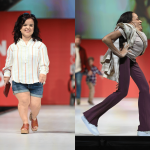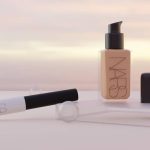The combining of two trade shows is not something one hears of often in the industry, however it was just that which occurred last week, as Copenhagen International Fashion Fair (CIFF) took prior competitor Revolver under its wing. The former acquired its contemporary counterpart in early January 2023 in a bid to offer both exhibitors and visitors of the Danish capital a more unified experience and order platform.
While the previous CIFF x Revolver mash up came in the form of separate spaces spanning two locations, for the SS24 edition – which took place between August 9 and 11 – this was the first time that both organisations came together under the singular roof of the Bella Center, aligning with the unified ‘One Copenhagen’ vision, through which the goals and motivations of the duo have been fused. And it appears that the efforts of the fairs have paid off. On the first day alone, the number of unique visitors equaled that of the figures recorded over the entire three days last season. Speaking on the influx of attendees, CIFF director Sofie Dolva told FashionUnited: “The traffic has exceeded our expectations. As has the quality of traffic, because one thing is the number, but we also need the right people.”
While the turbulent weather conditions in Copenhagen may have driven people indoors and kept them inside, credit could also be due to the increased emphasis on hospitality services, with the expanded addition of cafes, local restaurants and pop-up experiences making the fair function almost like a small town in itself. Not only did the footfall garner positive feedback, as Dolva mentioned the quality of such traffic was also met with zeal. Exhibitors reported a wider scope of buyers flooding through the doors, many larger retailers than they had seen at past events, as well as descending from a more expansive radius in terms of geographies. Alongside more European buyers, namely from the likes of Norway, France, Spain and Germany – which is one of CIFF’s most important markets – there were also attendees from North America, Asia and Australia, pushing exhibitors to think beyond their routine territories.
International buyers drive strategies
For first timer Unbreak It, a German brand that has its production in Italy, sights had initially been set on developing in the Scandinavian market. However, many visitors showing an interest in the brand originated from the likes of France, Japan, Turkey and Spain, making the product manager of the label Georgia Both more aware of her need to work alongside an agent that knows each of the markets more broadly. Similarly, a Danish womenswear brand, whose collections are embedded in the use of upcycled vintage materials, had a similar experience, initially setting out to communicate with its local clientele before pivoting slightly towards the more global. Having last shown at Revolver two years ago, this new set up has convinced the sales manager of the label to return to CIFF next year, as the brand’s northern headquarters in Denmark are often hard for both local and international clients to reach.
The experiences of smaller brands were also mirrored in those of the larger agencies, as was the case for DK Company, a Danish fashion and entertainment group that inhabited an entire corner of the fair spanning two levels. Next to clothing, the firm also hosted a bar, cafe and, at some points, music sets, elevating its expansive space for all those that stopped by. And those that did differed greatly from what DK Company had seen in previous years.
Commenting on the footfall, Jakob Hillerup, who serves as the export manager for DK brands St. Tropez and Soaked, said: “We are seeing a lot more customers now because last year they could only be at one place at a time, and then didn’t have the time to come to the other show. The main thing now is that we see all types of clients, also the ones that didn’t come to CIFF before. There’s more contrast in the retailers that are stopping by. You suddenly have high-end retailers who normally only buy at a certain level, but now they have the time to visit this space where they can get to know the different labels. Then we can also get some feedback from a different kind of client that we didn’t see before.”
Thought-provoking design qualities bolstered by consumer demand
Hillerup said the company had been in communication with potential clients in the US, Australia and all over Europe, supporting its mission of targeting new markets. In his perspective, such interest has stemmed from retailers particularly seeking Scandinavian design, something that Soaked has been able to strongly cater to following its brand transformation, which last year consisted of unveiling a new logo and brand identity. This has then allowed DK Company to reposition the label towards retailers and consumers looking for high-end products at a lower price point. Hillerup added: “The customer may be holding back a little on money right now. That’s why we are having a really strong season, because we have products that look expensive with the same qualities, but at the right price. Customers are buying a little bit more safely, but also being intentional about purchasing items that can last a longer time while buying less than they used to.”
Similar shifts in approach were also seen at Odd Molly, where prospective buyers were present in the form of both new and existing customers. A representative for the brand added: “We are focusing more internationally right now. Even if Sweden is our home market, and will always be there, we are looking abroad just because we have seen a lot of international people (at CIFF).” Clients from these markets have also expressed interest in a wider range of Odd Molly’s bohemian-inspired collections, straying from the usual Scandinavian tendency to stick to muted, subdued styles and colours.
This sentiment was also shared by Samia Bavab, an assistant designer at the colourful knitwear brand DawnXDare. Launched in 2016 in Copenhagen, the womenswear label sells across markets in Scandinavia, wider Europe, Asia and the US, catering to a more niche clientele who resonate with its handmade approach to design. Circularity is at the core of the brand, which offers a main line next to a secondary deadstock line, formed using scrap yarns from previous collections. Its excessive use of colour, however, is what drew in a wider scope of buyers. Speaking on what products have been most sought after, Bavab said: “In the UK, they loved the pink tones, whereas over in Norway, it’s a little more earthy. It’s fun to see different markets approach the brand. We gain a better sense of varying colours.”
This flow of traffic was something CIFF’s Dolva had been intentional about, present in the thought-out approach she had to the fair’s new floorplan, considering the inflated roster of brands in one space. Speaking on the layout, Dolva said: “The way we have chosen to segment this time is to make sure that we have spread around the traffic drivers, so that everybody gets traffic. Instead of having a really clear segment for things like commercial, affordable luxury, contemporary, etc., we have small groups from those segmentations in between each other, while still splitting men’s and women’s. Because it’s so new, and there are so many brands, we at least wanted to try to make sure that the buyers will then discover new brands and not be in a box. That’s why we’ve also chosen to do the ‘Ikea model’. It’s also why we just used colour names instead of ‘Contemporary Women’s’, for example.”
Fresh concepts draw in the crowds
A central part of this rejuvenated model was that of the beauty section, introduced by CIFF in February and expanded for this season, granting it an area of its own off from the bustling fashion halls. While some of the participating beauty brands touched on a desire to also be woven among fashion, Dolva expressed the need for a dedicated space for this contrasting market: “For me, it was important for the beauty section, having so many fashion brands, to create an area where there was a more calm environment so you could really take in the impression and use all your senses. If you had the beauty section in the middle of the main halls, where it’s so vibrant and dynamic, it would take away from it. That was the initial idea. I think people really enjoyed going from the busy area into another universe.”
Those in beauty did report a marginally positive footfall and a sense of heightened awareness from visitors compared the season before, falling in line with a more general consensus that fresher concepts had been reeling in larger audiences. Danish plus-size label Anyday, for example, attended the show for the second time, having first exhibited in February. However, this time brand manager Camilla Urban stated that she had seen bigger retailers stopping by. Compared to surrounding exhibitors, Anyday’s collection was firmly rooted in the flashy Barbiecore movement, with sparkles galore encasing designs for EU sizes 42 to 56.
If there was one thing Urban wanted to see from CIFF next time it was an increase in representation for plus-size brands, as she found that clients, many having signed with Anyday during the fair, were actively seeking such labels. Urban added: “One of our target groups are brands and stores that are selling sizes 44 and 46, but might also be considering selling 48, 50. Then they can mix and match. We do also focus on original plus-size stores, but I think that this inclusiveness is quite important. I see it as a trend for multi-brands stores, where friends of all shapes can shop in one place.”
Another stand capturing the attention of passing visitors was that of Ichi, which like seasons before opted for both a showroom – present on the upper levels – and a pop-up. It was the latter that had attendees talking, largely down to a set up where it was possible to customise your own tote bag and t-shirt with iron-on transfers. Over the first two days, the brand already used up 500 of its customisable shirts, which a member of the brand’s marketing team, Nynne Larsen, said had contributed to drawing people in so as to communicate with them about the brand itself. Not only that, but the brand’s newest marketing strategy also garnered a spotlight. Launched last year, the label has repositioned itself towards becoming a more global player, travelling around the world to share stories of individual self-expression. Larsen added: “The bottom line is that we want to create a more diverse fashion scene, where people are allowed to be who they are and express themselves as they are.”
The question of date and the backdrop of fashion week
While the merging of the two events has seemingly gone according to plan, one of the biggest operational issues faced was the introduction of an app, where visitors could view their ticket and the show’s floor plan, complete with Bluetooth navigation. Like with any new tech attempt, issues arose, causing a slight setback to what was meant to be a good intention. This was mainly due to the misunderstanding of visitors needing the app in order to enter, while the map itself also experienced some navigational problems. Such challenges seemed to have found a resolution by the second day and the fair went ahead without much of a hitch.
For Dolva, however, these obstacles are all part of the learning process. Her approach to the fair is a one set in logic and data, all of which link to the definitive decisions she makes. One example of this is the question of dates – a debate that isn’t entirely exclusive to CIFF. Yet, on speaking to exhibitors it became clear that a handful expressed an interest in an earlier time slot for the show, a one that would allow for it to take place closer to similar European trade events, such as Pitti and Premium.
While nothing on this matter can be confirmed, Dolva did state that such a discussion was indeed ongoing: “Ever since I have started I have heard this issue about dates. It’s been going on for many years. My mindset is very logical, I also need to see data. We have sent a survey out to all exhibitors and previous exhibitors to collect feedback and then see how this is split – whether they would like to move the date from August to the beginning of July, for example, and if we did, would they still come? My priority is to make sure that the brands have buyers that still have budget and that they come.”
The current date also enables CIFF to take place simultaneous to Copenhagen Fashion Week (CPHFW), a deliberate plan as the fair looks to also support the participating designers in building their business. On this point, Dolva said: “For emerging talents, it’s a key priority for them to establish a network with the buyers and to enter retailers, because if you don’t have the business, you can’t have the show. Those are the people that get the most out of being in the trade fair, because then they get traffic from all around. They learn also from the other brands. I think it’s great with a show to create some awareness.”
With the latest edition of CIFF now wrapped up, Dolva can now set about gathering the valuable knowledge gained from this latest event in order to inform the next. When asked about plans for next year, she concluded: “We want to have everything under one roof again, but it will be a different floor plan. We will take advantage of some of the other spaces that we’re not utilising this time. We have promised ourselves that we won’t carve anything into stone before this edition is done, because this is just the first time for so many brands to be together. It’s really important to learn from it and from these lessons we build a new plan.”



